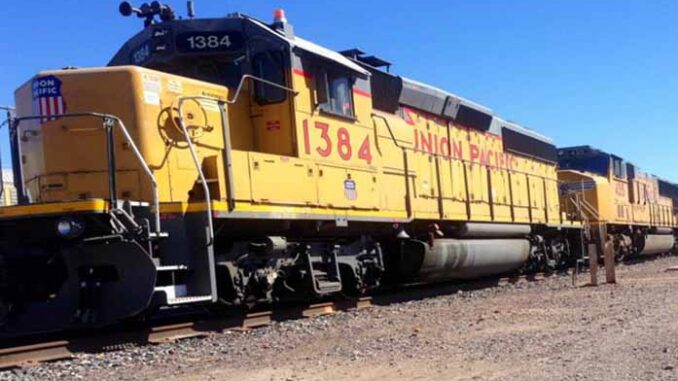
The big boys of global capitalism are planning for something huge between El Paso Texas and the Pacific.
Like astronomers ascertaining the presence of something hidden by the movement of adjacent bodies, the same thing is shaping-up to affect Tucson’s signature real estate development, i.e. its downtown re-make, a.k.a. Rio Nuevo.
I can make the case, Tucson needs to act quickly to mitigate most of the rail infrastructure in the downtown area. Not addressed, what will confront people by 2030 may be a stepped-up noise, rail, and 18-wheeler traffic matrix, making life unbearable in that zone.
It’s all coming about due to this slow motion, external (hundreds of miles away) realignment of America’s “Pivot to the Pacific”. Itself the result of new national security, technology, and global trade changes …very seminal changes.
If the Sonoran Mexicans succeed in their plans for the Port of Guaymas, and the reconfiguration of the rail line to and around Nogales, this will set in motion a 2nd railroad revolution for southern AZ. Aspects I noted in my previous piece on Sonora’s awakening to its Pacific potential.
Two critical developments in Sonora have just occurred since that last piece on the Mexican state. Singapore financial interests, in conjunction with their partners in the US Permian Basin (WTx & NM) & Mexico, have transferred site properties for construction of a planned, multi-billion $$$ natgas liquefaction port facility at Guaymas.
And Ford Motor Company is now seriously studying how to transform their existing Hermosillo plant to become their largest Pacific-oriented EV manufacturing & export facility. They’ve been meeting with Sonoran officials and other material, mining, and transportation players in an effort to work out a broad concept and some key details.
This included not only Ford, Mexican state & municipal officials, but representatives of Grupo Mexico, which owns the Port of Guaymas and the FerroMex rail line, under which Ford has long chaffed. In addition, Chinese interests from Bacanora Lithium, the gigantic Sonoran lithium deposit, have also been present.
Since exiting Brazil in 2021 after more than 100 years, Ford has recommitted to a major strategic gamble on North American (read: NAFTA-the-sequel) electric vehicle production. This is a ‘1-foot-at-a-time’ strategy beginning with a new multi-billion $$$ EV plant northeast of Memphis, now under construction, and its new battery plant complement, close to Appalachian lithium deposits in Stanton, KY.
But now the tantalizing aspect of the largest lithium deposits in North America, amazingly close to their Sonoran manufacturing ops, and with possible enhanced port/rail facilities on the Pacific, and further access into the North American rail-grid, looks to be an intriguing piece of the puzzle. Stay tuned.
Meanwhile North-of-the-Arizona-Border: Not only will all this Sonoran-Pacific action validate the pending gigantic investment BNSF railroad is about to make west of Phoenix, it will also validate Union Pacific’s relatively new (2014), similar intermodal facility just west of El Paso, in Santa Teresa, NM. No doubt BNSF will negotiate joint trackage rights from their new multi-$-billion Phoenix facility, to Nogales; otherwise it’s stranded from the lion’s share of business flowing South to North.
Also, from their main respective points on the border, the Mexican railroad, FerroMex, will be able to service both American giants and the Port. The subtext here from the 2 US rail concerns, “we’re counting on it, and betting big money.” Things get even more interesting with the emergence of the “E_Economy” and the necessity of large mining operations (lithium, copper, etc) in our transborder region.
All of this will throw an incredible amount of UP (& later BNSF) rail traffic through downtown Tucson, to their undersized yard, just 1.1 miles southeast. This was the same consideration UP & BNSF underwent after NAFTA was born, in downtown El Paso, with UP making the determination (2010) to do their big Santa Teresa operation further west in the NM desert. Now BNSF is doing the same outside of Phoenix.
But wait, there’s more …an outlier to this emerging Arizona rail nexus could be the proposed refurbishment of an abandoned rail line from the booming Tijuana Metro manufacturing center (yes, Tijuana, pop. ~2.5 million), and its rapidly expanding Pacific port of Ensenada, ~50 miles south. That border-zone RR line would run northeast to Plaster City, CA, where it could later link-up with Union Pacific (going into Tucson).
Currently, the Tijuana proposals have failed because of amateurish undercapitalization of the complex rehab. But experts agree this line would solve many problems now bedeviling rail & port operations there; Baja de Norte state government is very keen on this development strategy.
In closing, I apologize in advance if it turns out—with these observations, I’m the skunk at the Rio Nuevo garden party. That is not my intent; but rather to inform Tucson “leadership”, you’re not in a 1-taco-stand-town anymore.
Sellers is a Southpark Republican living in incorporated Oro Valley; his background is federal technology commercialization

